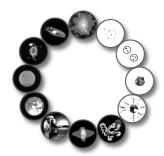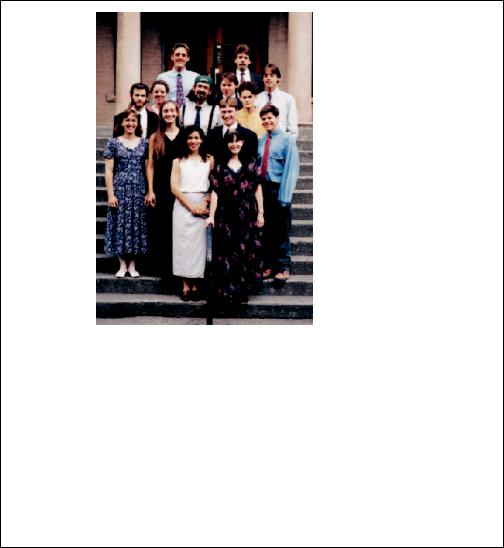
6288
.pdf
Nuclear Physics: The Core of Matter, The Fuel of Stars
http://www.nap.edu/catalog/6288.html
144 |
NUCLEAR PHYSICS: THE CORE OF MATTER, THE FUEL OF STARS |
||
|
alargeneutrinodetectorusedatLAMPFtostudywhetherornotneutrinooscillationsoccur. Theactivedetector |
liquidviewedbyabout1,000largelight-detectingphotomultipliertubes. Thisexperimentprovidesevidencethat |
doinfacthavefinitemass. (CourtesyofLosAlamosMesonPhysicsFacility.) |
|
FIGURE6.8 Theinteriorof |
isalargetankofscintillating |
couldindicatethatneutrinos |
Copyright © National Academy of Sciences. All rights reserved.
Nuclear Physics: The Core of Matter, The Fuel of Stars
http://www.nap.edu/catalog/6288.html
SYMMETRY TESTS IN NUCLEAR PHYSICS |
145 |
time, several large underground detectors indicated that the ratio of muonand electron-type neutrinos detected underground was inconsistent with expectations based on a seemingly reliable estimate. The SuperKamiokande experiment has dramatically demonstrated that the anomaly can be traced to a difference in the number of upward going and downward going muon-type neutrinos that are detected. The conclusion is that muon-type neutrinos seem to be oscillating on their way to the detector, but that electron neutrinos do not oscillate by a detectable amount in that distance. That the electron-type neutrinos do not show evidence for oscillations here would be completely consistent with the conclusions from CHOOZ, the most recent and most sensitive long-baseline reactor experiment, and also with the solar results, indicating a rich structure of neutrino masses and mixing parameters in satisfying analogy to what is seen for the quarks. Many questions remain. Why are the neutrinos so light? Are neutrinos the same type of fermions as the charged leptons? Or, in the jargon of the field, Are they Majorana or Dirac particles?
Neutrinos with mass could have a dramatic effect on the extremely rare process of double beta decays. Double beta decay, with the emission of two electrons and two neutrinos, is simply the rare coincidence of two simultaneous beta decays. Two-neutrino double beta decay is expected to occur, even with massless neutrinos. Double beta decay was predicted early in the century, but it was directly observed only during the last decade. The first direct observation of this process was an experimental milestone made possible by some of the most advanced modern techniques of low background counting, invented specifically for this research. The observed double-beta-decay lifetimes are many trillions of times longer than the age of the universe. By now, two-neutrino double beta decay has been seen in about a dozen different isotopes. Double beta decays without neutrinos are also possible, if neutrinos have mass and are of the Majorana type, meaning that they are their own antiparticles. In this case, a neutrino emitted by one neutron can be absorbed by another, leaving two electrons that share all the decay energy. Double beta decay, with or without neutrinos, can be the dominant mode of decay for certain nuclear systems that are energetically forbidden to decay by ordinary beta decay. Neutrinoless double beta decay has not yet been observed, and whether or not neutrinos are of the Majorana type is still an open question, the answer to which will have profound implications. The current upper limit on the electron neutrino Majorana mass, derived from limits on neutrinoless double beta decay, is less than about 0.5 eV, and, thereby, experiments have already eliminated a number of previously proposed Standard Model extensions. The most sensitive experiment used several kilograms of isotopically enriched 76Ge, which decays by the double-beta process. In this experiment, the 76Ge itself was made into a detector capable of measuring the energy of decay electrons with excellent resolution. To avoid backgrounds, the experiment was done in an underground laboratory. Despite the great difficulties (the double- beta-decay process was observed only ten years ago for the first time), there has
Copyright © National Academy of Sciences. All rights reserved.
Nuclear Physics: The Core of Matter, The Fuel of Stars
http://www.nap.edu/catalog/6288.html
146 |
NUCLEAR PHYSICS: THE CORE OF MATTER, THE FUEL OF STARS |
been tremendous progress in this field. There are now numerous observations in different systems. Experiments are being proposed that could improve existing limits on the neutrinoless process by orders of magnitude. Interpreting the limits in terms of fundamental neutrino parameters requires a close collaboration between the experimentalists and nuclear theorists.
THE WEAK INTERACTION WITHIN
THE NUCLEAR ENVIRONMENT
The nuclear interior provides a unique environment for studying the weak interaction between hadrons, with no leptons involved. The weak force is exceedingly feeble compared to the strong nuclear force, but parity violation provides us with the necessary clue for recognizing its effects. While the weak force can mostly be ignored in describing the structure of nuclear systems, it still introduces a small violation of mirror-reflection symmetry. The weak interaction in its purest form has too short a range to act directly; instead, it organizes itself as a perturbation to the various meson exchange forces between the nucleons. Much has been learned about the weak hadronic interaction, but significant puzzles remain to be solved. Sensitive experiments combined with sophisticated theory are still inadequate to provide a completely consistent picture of the structure of the weak force within the nucleus. Investigations of the weak-interaction- induced parity mixing of nuclear levels in well-chosen systems can discriminate between the charged current (arising from W exchange) and neutral current (arising from Z exchange) components of the nucleon-nucleon weak force. The effect of the charged currents is consistent with expectations, but there is no clear evidence of the expected neutral current effect in nuclei. However, recent evidence of a nuclear anapole moment (basically a doughnut-shaped or toroidal nuclear magnetic field configuration within a nucleus) from studies of atomic parity mixing is consistent with the expected size of the nucleon-nucleon neutral current. New experiments are clearly called for. Although the effects are extremely small and hard to observe in the nucleon-nucleon system, they have been seen directly in proton-proton scattering. A new experiment is planned to measure the effect of parity violation on the gamma rays following the capture of polarized neutrons on protons. This experiment could solve the puzzle about the missing effect of the Z in nuclei, because it is free from the theoretical uncertainties that are required to interpret finite nuclei. However, the experiment is exceedingly difficult, because the size of the expected effect is only at the part in 100 million level.
The weak force should also affect the outcome of neutron-nucleus elasticscattering experiments. These experiments are sensitive to the interference of low-energy neutron capture resonances with angular momenta of zero and one. The method is exquisitely sensitive to a small parity-breaking force, because the nucleus acts as an amplifier. In experiments with polarized neutron beams from
Copyright © National Academy of Sciences. All rights reserved.

Nuclear Physics: The Core of Matter, The Fuel of Stars
http://www.nap.edu/catalog/6288.html
SYMMETRY TESTS IN NUCLEAR PHYSICS |
147 |
spallation sources, parity-mixing effects as large as several percent have been observed. Analyzing the observed effects in nuclei is an example of the interplay between nuclear structure and the fundamental interactions. Statistical models of the nuclear state distributions are used to extract the mean values of the paritymixing matrix elements. Figure 6.9 shows some of the data from a measurement of parity-violating neutron scattering on thorium. The size of the parity-violating effects indicates dramatically how the nucleus can be used to amplify small features of the fundamental forces.
EXOTIC PARTICLE SEARCHES, RARE DECAYS,
AND NUCLEAR PHYSICS
Nuclear systems are often exploited in attempts to verify speculations about hypothetical new particles. For example, nuclear experiments were instrumental in studying the possible existence of a particle called the axion, proposed several
FIGURE 6.9 Data from an experiment measuring the transmission of polarized neutrons through a target of 238U. The difference in transmission for the two neutron polarization states demonstrates parity violation in the nuclear force. The enormous effect, larger than a percent, is a consequence of the nucleus’s ability to amplify an exceedingly small intrinsic parity violation from the weak interaction.
Copyright © National Academy of Sciences. All rights reserved.
Nuclear Physics: The Core of Matter, The Fuel of Stars
http://www.nap.edu/catalog/6288.html
148 |
NUCLEAR PHYSICS: THE CORE OF MATTER, THE FUEL OF STARS |
years ago as a consequence of a new symmetry introduced to explain the observed CP symmetry of the strong interaction. As first proposed, the axion would decay to two photons or positron-electron pairs. Over the course of several years, this possibility was ruled out by a series of searches, primarily using nuclei. Unfortunately, the mass of the axion and its interaction strengths are not completely specified by theory, so experiments have not yet excluded them completely. An ongoing experiment searches for very light axions. This experiment exploits the predictions that axions couple to photons and that very light ones should have an effect on a finely tuned electromagnetic resonance cavity.
Nuclear techniques have been applied to searches for free quarks, very light scalar particles, and several other possible particles suggested by various theories. Nuclear physicists have been quick to apply their sizable arsenal of experimental techniques to discovering whether or not particular proposals concerning new particles correspond to what actually exists in nature.
Decay mechanisms that are forbidden within the context of the Standard Model might otherwise be expected. For example, the proton should be stable in the Standard Model, but it is expected to have a decay mode in various grand unified models, which extend the Standard Model by including quarks and leptons in more democratic multiplets. Proton-decay experiments have mostly been undertaken by high-energy physicists, with some participation from the nuclear physics community. These experiments are being steadily improved, and the upper limit on the proton lifetime is now longer than about 1032 years. A related process of neutron-antineutron oscillations was also an active area of investigation during the last decade. Again, no effects were seen, but useful limits were obtained from experiment. Observing forbidden decays of mesons and leptons might also be signals of physics beyond the Standard Model. One possibility that has received much attention is the search for the decay of the muon into an electron and a gamma ray. Several attempts to find this process have been made at medium-energy accelerators around the world. These limits, like the limits on the neutron and electron electric-dipole moment, provide some of the best constraints on supersymmetric extensions to the Standard Model.
OUTLOOK
This area of research is motivated by a desire to gain new insights into the most fundamental aspects of the structure that underlies nuclear physics. It has remained a vital subfield of nuclear physics because the issues are fundamental and because a constant flow of new experimental opportunities has been made possible by capitalizing on advances in experimental physics. Advancements in the fundamental experimental tools of nuclear physics—the newest accelerators and the most advanced detector systems—are essential for the future health of this research. Ironically this research area also relies on some of the oldest accelerator facilities of nuclear physics. Much of the work is carried out at small
Copyright © National Academy of Sciences. All rights reserved.
Nuclear Physics: The Core of Matter, The Fuel of Stars
http://www.nap.edu/catalog/6288.html
SYMMETRY TESTS IN NUCLEAR PHYSICS |
149 |
accelerators at national laboratories and universities, small tandem accelerators, and cyclotrons. Access to small facilities with specific capabilities for particular experiments is also an important priority for this subfield. This area enriches the field of nuclear physics by sharing frontiers with other fields of physics, overlapping and enhancing work in atomic physics, high-energy particle physics, and astrophysics.
Although nearly all new facilities for nuclear physics will be exploited for testing the Standard Model, some future facilities have obvious utility that make them a high priority for the field. The new generation of intense sources of cold and ultracold neutrons hold the potential of allowing the Standard Model’s version of the weak interaction to be better tested in a simple hadronic system. Precision studies of neutron beta decay and better searches for a neutron electricdipole moment require access to the most intense research reactors and spallation sources available. Access to more intense neutron sources that become available in the next decade has a high probability of leading to a major discovery in this area of research.
The venerable area of nuclear beta decay has a new life because of the advent of new techniques of atom manipulation, new methods of polarizing nuclei, sophisticated online isotope separators, and new radiation detection methods. Ion or atom traps offer new opportunities for reducing the systematic uncertainties that now limit this research, but these techniques make more stringent demands on the production of particular radioactive species. A high-intensity ex- otic-beam accelerator would also be the source of radioactive atoms required for this research, and an exotic-beam facility is a high priority for this area of research.
In the next five years the newest solar neutrino experiments should finally resolve the question of whether or not the neutrino and its interactions are the cause of the solar neutrino problem. The discovery of neutrino masses and mixing could lead to the next scientific revolution, leading to the first significant change in the Standard Model two-and-a-half decades after it was established. Currently there are two other experimental indications that neutrinos may have mass. The signal from atmospheric neutrinos should be elucidated in a series of planned, long-baseline experiments at accelerators. The second indication appeared in a medium-energy nuclear physics accelerator experiment. Nuclear physicists will continue to participate in the follow-up experiments that should resolve these issues in the coming years.
Copyright © National Academy of Sciences. All rights reserved.

Nuclear Physics: The Core of Matter, The Fuel of Stars
http://www.nap.edu/catalog/6288.html
150 |
NUCLEAR PHYSICS: THE CORE OF MATTER, THE FUEL OF STARS |
7
The Tools of Nuclear Physics
INTRODUCTION
Nuclear physics is a science driven by experiment, so its progress depends critically on advances in instrumentation. New developments in accelerators, detectors and their associated electronics, data acquisition systems, and computers for data analysis have been the bases for rapid developments in the field and provide the technical underpinnings for today’s thrusts in nuclear physics.
Given the range of nuclear phenomena, and the corresponding length and energy scales at which we observe them, a large variety of experimental instrumentation is needed and is continuously being developed. This spectrum includes various types of accelerators that provide a broad range of beam species and energies, as well as the particle detectors to register and identify a diverse range of reaction products.
Beams of nucleons and nuclei from low-energy accelerators are used to excite the nucleus as a whole. At the other end of the energy scale, high-energy lepton and hadron beams probe the distance scales relevant for the subnucleonic structures of nucleons and nuclei. Colliding beams of massive, highly relativistic nuclei transiently generate nuclear matter at the highest energy densities and hadron densities, offering the possibility of observing the quark-gluon plasma. In addition, exploring spin degrees of freedom requires polarized beams (and targets), while beams of mesons and strange baryons uniquely probe specific aspects of the strong interaction in nuclear many-body systems.
To the same extent that a diverse assembly of accelerators with widely varying characteristics is needed to cover the range of beam species and energies
150
Copyright © National Academy of Sciences. All rights reserved.
Nuclear Physics: The Core of Matter, The Fuel of Stars
http://www.nap.edu/catalog/6288.html
THE TOOLS OF NUCLEAR PHYSICS |
151 |
needed for nuclear physics, detectors of greatly varying characteristics have been and continue to be developed for a spectrum of experimental observables. These range from the high-resolution detection of optical radiation at eV energies in studies of nuclear hyperfine structures, to sophisticated multidetector arrays needed to disentangle thousands of reaction products in high-energy nuclear collisions, and to scintillation detectors of thousands of tons buried deep underground to register the most elusive particles in nature, the neutrinos coming from the cosmos, the Sun, or from accelerators. Detectors are used in stand-alone mode, as in the underground neutrino experiments; as single detectors and small arrays at low-energy facilities; and in vast assemblies of complex particle detection systems at the facilities with the highest-energy beams.
The continuous advancement of accelerators, detectors, and data acquisition techniques provides a rich milieu for training and innovation over a wide spectrum of technical areas, including electronics, vacuum technology, large-scale data acquisition and computer systems with corresponding software development, novel detector materials and sensors, automated high-level control systems, ion-beam and accelerator technology, and superconductivity.
The experimental work in nuclear physics goes hand in hand with the development of theoretical understanding. The theoretical effort is undertaken by a number of researchers at universities and laboratories. An important part of the infrastructure of the field is the Institute of Nuclear Theory, described in Box 7.1.
ACCELERATORS
Nuclear physics needs primary beams of electrons, protons, and heavy ions over a wide energy range. Each serves a complementary class of experiments. Secondary beams of other particles, such as neutrons, pions, muons, neutrinos, and radioactive ions, can be derived principally from intense proton and heavyion beams. Accelerator facilities for nuclear science fall into two major categories: larger facilities that operate for substantial outside-user communities, and smaller facilities that mainly serve local groups of scientists.
Historical Perspective
A variety of accelerators was invented, built, and used in the 1930s to begin the exploration of nuclei. During the 1950s and 1960s, needs from nuclear physics experiments led to major improvements in these technologies and a number of accelerators, cyclotrons, and Van de Graaffs (now considered small) were constructed and used for research at university laboratories. As the requirements for beam energies, intensities, and especially beam species grew, larger dedicated facilities were built at universities and at the national laboratories. It was also during this period that high-energy physics started, and the accelerator developments of nuclear physics formed the basis of the first high-energy facilities—
Copyright © National Academy of Sciences. All rights reserved.

Nuclear Physics: The Core of Matter, The Fuel of Stars
http://www.nap.edu/catalog/6288.html
152 |
NUCLEAR PHYSICS: THE CORE OF MATTER, THE FUEL OF STARS |
BOX 7.1 The Institute for Nuclear Theory
The formulation of our theoretical understanding of nature and frequent, detailed discussions between theorists and experimentalists, are key elements to progress in physics. About a decade ago, with CEBAF and RHIC on the horizon, the Nuclear Science Advisory Committee recommended establishing a center for nuclear theory. As a result, the national Institute for Nuclear Theory (INT) opened its doors in the spring of 1990 at the University of Washington in Seattle.
Some of the goals of the INT are as follows:
•Create a research environment where visiting scientists can focus their energies on key frontier areas;
•Encourage interdisciplinary research at the intersections of nuclear physics with related disciplines, such as particle physics, astrophysics, atomic physics, and condensed matter physics;
•Recruit and nurture the best young researchers;
•Contribute to scientific education through INT schools;
•Strengthen international cooperation in nuclear physics and physics generally, through cooperative programs and exchanges.
The INT contributes in important ways to the vitality of nuclear physics. It sponsors three programs each year focused on specific physics questions and draws visiting physicists from the United States and abroad who are expert in the subject area. The INT also sponsors an annual series of schools and smaller workshops (e.g., see Figure 7.1.1), many of the latter organized quickly in response to urgent developments in the field.
The INT has enjoyed remarkable success from its inception. The three main programs attract approximately 200 visitors each year for an average stay of about one month. Approximately 60 percent of the visitors are U.S. physicists; the rest come from around the world. The concept behind the programs is that close discussions among groups of experts will both sharpen the physics questions and speed progress on their resolution. This includes issues specifically related to experiment: most programs include significant participation by experimentalists, who describe what can be measured and how theory might be of help in their analyses. Many of the more interdisciplinary programs have drawn equal numbers of participants from several physics subdisciplines. Recent examples of such programs include nucleosynthesis, atomic clusters, Monte Carlo techniques in strong-
greatly aided by the discovery of strong focusing. In nuclear physics the Los Alamos Meson Physics Facility (LAMPF) was the premier large nuclear physics facility in the United States for many years. At the same time, innovative technological developments and extensions of existing smaller accelerators—supercon- ducting magnet developments, post accelerators based on superconducting radiofrequency technology, ion sources for highly charged ions, intense polarized
Copyright © National Academy of Sciences. All rights reserved.

Nuclear Physics: The Core of Matter, The Fuel of Stars
http://www.nap.edu/catalog/6288.html
THE TOOLS OF NUCLEAR PHYSICS |
153 |
FIGURE 7.1.1 A group of students in front of the Institute for Nuclear Theory, participating in INT’s Research Experiences for Undergraduates program.
ly interacting many-body systems, and connections between high-energy and lowenergy precision measurements of the weak interaction.
The INT workshops, which typically run from 2 to 5 days, attract another 200 visitors each year. Two of the workshops are an ongoing annual series cosponsored by CEBAF and RHIC. They have as their focus the theory needs associated with specific experiments. Other occasional workshops have involved collaborative efforts with INT’s counterpart in atomic physics, the Institute for Theoretical Atomic and Molecular Physics (ITAMP) at Harvard, and with overseas institutes. Still others are sponsored entirely by INT in response to urgent physics questions. A recent example was a workshop on the nuclear physics of the pp chain, crucial to the interpretation of solar neutrino experiments. The INT helps administer the National Summer School in Nuclear Physics, an annual school for advanced graduate students.
electron and proton beams, storage rings for leptons and hadrons—have provided new and unparalleled capabilities for nuclear physics research. In addition, highenergy physics facilities were used in certain areas of nuclear physics. For example, the Lawrence Berkeley National Laboratory (LBNL) Bevatron was modified to become the Bevalac, the first high-energy heavy-ion accelerator, and nuclear physicists carried out a number of experiments at the Stanford Linear
Copyright © National Academy of Sciences. All rights reserved.
